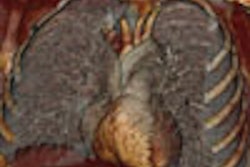CHICAGO - As electrophysiologists perform more pulmonary vein isolation procedures to treat atrial fibrillation, preprocedural CT angiography may help avoid potentially fatal complications by showing anatomic variants and proximity of a vulnerable esophagus.
The potential benefits of preablation CTA were suggested by Dr. Ethan Halpern, a professor of radiology at Thomas Jefferson University in Philadelphia, in a presentation Monday in cardiac sessions at the RSNA meeting.
Left atrium ablation/pulmonary vein isolation procedures are increasingly popular treatments for atrial fibrillation, Halpern noted.
However, the related risk of complications such as esophageal injury and esophagoatrial air embolization has only recently been highlighted in the medical literature (Journal of Thoracic and Cardiovascular Surgery, April 2003, Vol. 125:4, pp. 836-842).
Halpern and co-investigators sought to clarify the potential risk by documenting the frequency of pulmonary vein variants, and the distance between the veins and the posterior wall of the left atrium (LA) to the esophagus.
Eighty subjects were examined with coronary CT angiography studies performed on a 16-slice scanner using 100 cc of intravenous contrast.
The average distance between the esophagus and each pulmonary vein (PV) ranged from ranged from 4.1 mm for the left superior PV to 19.5 mm for the right superior PV.
At least one pulmonary vein was found to be in direct contact with the esophagus in 47 out of 80 patients. A portion of the posterior LA wall was in direct contact with the esophagus in every case, Halpern noted.
That close proximity documented by CT and attendant risk may have been a surprise to the cardiologists, he suggested.
"What was interesting to me was that the electrophysiologists actually were not aware that this was such an important issue."
Additional findings included six patients with a variant of a common trunk for the left superior PV and left interior PV, and one trifurcation of the right interior PV.
Other issues have also spurred the routine use of preprocedural coronary and pulmonary CTA at Thomas Jefferson, Halpern said.
"We now do all of our preprocedural cases also as coronary angiograms because many of these patients may have coronary disease as part of the reason for their arrhythmia," he said.
By Tracie L. Thompson
AuntMinnie.com staff writer
November 28, 2005
Related Reading
Cardiac CT strategies cut dose, keep image quality, November 25, 2005
MDCT/electroanatomic mapping fuse for atrial fib intervention planning, November 3, 2005
MDCT edges US for fibrillation RFCA planning, March 2, 2005
Catheter ablation for AF improves outcomes in heart failure, December 2, 2004
RFCA for afibrillation evolves with MDCT, July 23, 2004
Copyright © 2005 AuntMinnie.com



















